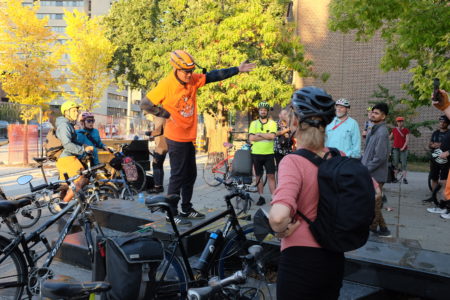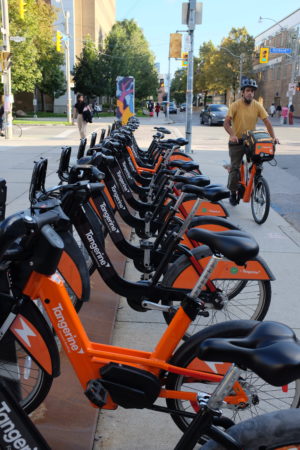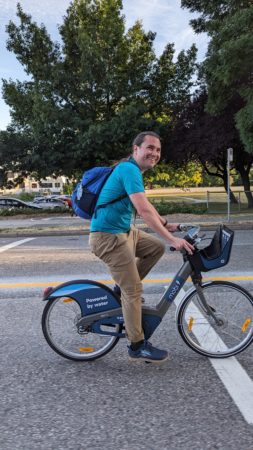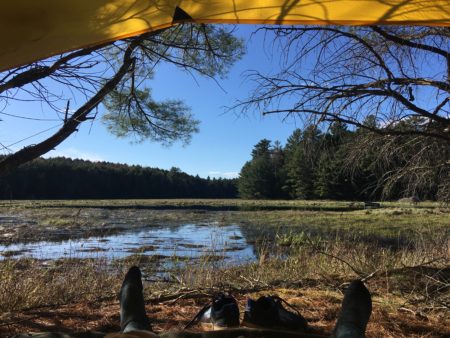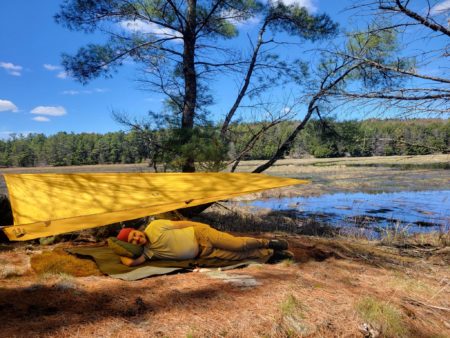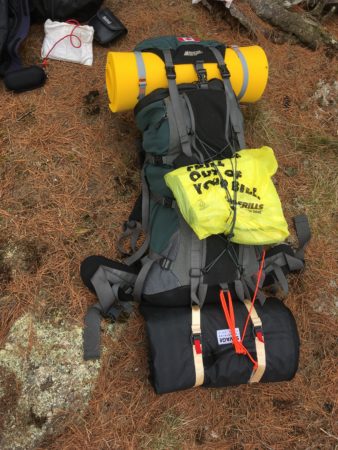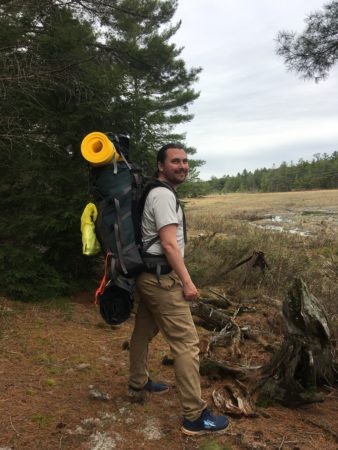Category: The outdoors
Hiking, camping, canoeing – if it’s an outdoor adventure, it should be under this heading
Bike Share Toronto on campus at U of T
First six days with Bike Share Toronto
An ebike is a great way to see Vancouver
Critical Mass Vancouver, July 2023
Milan Ilnyckyj at July 2023 Critical Mass in Vancouver, by @jordanvegbike
By happenstance or grace I ran into the best Vancouver Critical Mass in years when the library ushered me out at 6pm. It was my first bike ride in 11 years, and my first e-bike ride ever, on a rental e-bike available right beside the mustering area north of the old art gallery.
Critical Mass is one of the most brilliant forms of non-violent direct action ever devised. Today’s Vancouver ride showed me the city like I never saw it in 22 years growing up, and felt like the safest bike ride I ever took. Safe in the middle, I never worried about a single car. There were pairs of kids on the back of long e-bikes; dogs in carriers wearing goggles; several audio mixes from portable speakers in different parts of the mass; and a lot of good grace and patience — as well as a great deal of overt support — from pedestrians as well as drivers.
Vancouver
We have arrived safe in North Vancouver via Kamloops, Lillooet, and Whistler — managing to avoid any major fire delays more by luck and Sasha’s dedication behind the wheel than by foresight and planning. He did all our driving in three back to back days, and did today’s stretch through the heaviest traffic, steepest and twistiest roads, and our only night driving of the voyage.
We worked in a few short pauses to enjoy the views from the mountains. I hadn’t realized how beautiful the area around Lillooet is, with a semi-arid landscape, rocky peaks overhead, and vertiginous drops into the river canyon. It would be a fine place to return in no hurry and with a tripod and landscape photography gear. A hot tip from a German man at a roadside viewpoint took us on a ten minute hike to a stunning panoramic view at 50.65983, -121.98589.
A stop in Pemberton yielded kimchi and pulled pork sandwiches and smashed fries, which seemed just right as our last rest and meal of the journey.
After a night in tents and three solid days of driving, the last stretch in the dark through Whistler and Squamish had Sasha showing his only noticeable fatigue of the journey, which we countered with lively songs and an effort I made to dance in my seat to kinetically counteract the idea of tiredness.
Our parents welcomed us late in the evening with great hospitality and kindness. Because of the fires and the importance of Sasha not driving when too tired, I had been planning based on a five day drive with two extra days for delays and detours. As a result, I am in Vancouver with five days before the next phase of this visit is to begin. To pack light, I omitted to bring any camera gear, so my hope of digitizing the family albums on this visit is set aside.
While the time together was joyful and rewarding, we did spend the day very concerned about the fire threatening Bechoko. I watched the news and fire map updates while Sasha kept up with friends over messages and social media. The danger there is great and everyone has been directed to evacuate, and the structures and environs of the community are in peril. All we can do now is hope that the three homes that have already been lost will be all that are taken, and then regardless of the actual damage realized during this fire season do what we can to support the people impacted. I wish this unprecedented fire season was having a decisive political effect, pushing the public and politicians to accept that it is madness and a profound and irreversible betrayal of the young to keep producing and expanding fossil fuels. It isn’t really prosperity when you get or stay rich by burning up the prospects of those who will come after you, but our cognitive blockages to accepting and taking responsibility for the consequences of our actions continue to paralyze us into accepting a world-wrecking status quo. I don’t know what can break that complacency, but the way in which we carry on heedlessly incinerating the future with our coal, oil, and gas dependence is setting us up to be justly remembered as the generations that squandered the common heritage of humankind for the sake of our own ease and enjoyment.
Valemount
Sasha and I had a fine second day of travel. We woke in our comfortable room in Grimshaw and proceeded to Hinton, where there is a disc golf course which Sasha had praised. It was indeed excellent: ringed with majestic mountain peaks and wooded so as to add to both the beauty and the challenge. My only prior experience was a very informal round on the Toronto Island with my father and some cousins several years ago, so I largely stuck to the low-risk “hammer” technique of throwing the disc sideways from over my head, reducing the chances of an early or late release sending me way out into the woods, though I did have some 9–13 throw efforts on holes with par of 3 or 4 and I did a fair bit of searching for discs that landed out of sight in the undergrowth or which were taken in surprising directions by the sometimes-strong and gusty wind. One of those undergrowth searches brought me within five feet of a startled red fox, which bounded off immediately as I carried on the search for my ‘driver’ disc. The whole effort was a lot of fun, and Sasha introduced me to an Indigenous ritual of paying the land with tobacco and thanks partway through.
After that pleasant and contrasting athletic detour, we carried on into the towering Rockies and Jasper where, after I was put off by bistros with $30–60 dishes, we got salad and sandwich ingredients and found a scenic spot by a lake on our road forward for a satisfying picnic. En route we listened to the end of The Hobbit, and I felt the wisdom of Thorin’s dying words about how a world where food and cheer are valued above hoarded gold when Sasha lent me a fleece against the mountain cold and we enjoyed a delicious meal in an unbeatable setting.
From there we continued to our day’s objective of Valemount. Every hotel and motel was $250–300 and fully booked to boot, so we called around and found a campsite for what is predicted to be a rainy night and morning. Nevertheless, I felt glad at least before going to sleep about including a night of camping in our voyage home, in part because I brought a tent mailed to Toronto for him by my mother and because I had packed super-light for the trip in everything aside from my PhD grad gift tent, sleeping pad, sleeping bag, and collapsable pillow.
As I bed down for as early a sleep as I can manage, I am grateful for this concentrated time together with Sasha, for all the songs we sang along to along the road today, and for the quality of his company and conversation. I was likewise grateful to catch up on some of the events and people from our years apart. It was heartening to hear how many friends he has made in the community where he taught for the past two years, and what a good impression he has made on people there.
During one of the spans where I had cell phone service (I do not have it in the campground) I sent a selfie of us both with soaring mountains behind to friends and family.
There is a terrible fire near Kamloops, which is part of both efficient tracks home from here, so there may yet be delays and detours. With luck we will drive to Manning Park and have a hike there before proceeding to Vancouver. We budgeted a week for what could have ideally been a 3–4 day trip, so we may have some time together in Vancouver or a hike there too, or perhaps I will be able to go all the way to Victoria with him before returning to Vancouver at the end of the month for the second part of this west coast visit — my first since the Christmas Greyhound journey in 2009. Over the course of the drive we crossed the Mackenzie, Athabasca, and Fraser rivers, a who’s who of major watercourses in western Canada.
Back to the Claireville conservation area
We had to cancel a planned long weekend camping trip near Temagami because everyone is in crisis, but at least today I got a hike with three friends in the Claireville conservation area, a half hour bus ride west of Vaughan Metro Centre.
I appreciated the forested areas around shallow creeks, the frogs croaking in the marshes, and the bright weather which was neither unpleasantly hot nor oppressively humid. Strangely enough, the one unlocked bathroom we found was even air conditioned.
First night in the woods with the Savage Industries bedroll (v2)
My friend Natalia made a suggestion that gave me a 24 hour respite from the misery of finding a room in Toronto, and we went back to the Hemlock forest near Catchacoma for an overnight camp.
One great thing about short visits to a place that has a brief and easy walk between where we parked and where we camped is that it allows for pretty quick and low-risk evaluation of gear for backpacking and camping. It’s feasible to bring two of something and try both, and not that bad if you only bring one version of something and it doesn’t work.
I have been so happy with my Savage Industries EDC ONE bag that even though I can’t say I ever had “buy a bedroll” on my to-do list, when I saw that they had made one I was curious about it. I have been very pleased with their stuff in the past and I know it sells out fast, so when they issued a second release I ordered one in time to have it to show off at this week’s bluegrass / hike planning evening.
Before leaving, it seemed like a bit of a questionable camping item when a lot of people live some version of the ultralight philosophy. Just the bedroll weighs 4 pounds, and it rolls up into a package bigger than my tent or sleeping bag.
The design justified itself in the field for sure. It has waterproof sailcloth on the outside and a good warranty, so I felt fine about putting it down on little sticks and stones that I would move away from the area under my thin-floored tent. The wool platform was great to rest on after the hike in, and to watch the clouds from. At night, it was a great venue for stargazing, and I expect it will be good for tent-free “cowboy camping” later in the season.
Back in my tent — where on the last trip I spent all night curled at the bottom of my sleeping bag and shivering for warmth — I followed Natalia’s advice to put the bedroll above and below my light sleeping bag. In that configuration, I was warm with my sleeping bag unzipped until after dawn, and then warm with the bag zipped and light clothes on after. Note, however, that we had -11 ˚C and -9 ˚C nights last time, compared with +5 this time. (Though last time, I also used a fleece sleeping bag liner which I never had to pack this time, and slept in all my clothes rather than light PJs.)
One more nice unanticipated feature emerged when we were breaking camp: the bedroll is large enough to use as a soft, dry, and debris-free place to roll up my tent. Being able to pack up a tent clean saves times and annoyance, reduces the odds of needing to unpack it later in the day to dry or clean it, and probably extends the life of the tent.
For the hike out, I even discovered that the integrated straps on the bedroll can be passed through two loops that were already there at the bottom of my pack. The bedroll still needs to be tied so that the middle doesn’t slide out of the roll, but the bedroll is nevertheless quite feasible to carry attached to the outside and bottom of a pack.
I probably would not carry it on a thru hike of thousands of kilometres, but it seems great for trips like this one plus picnics and Hive games in the park.
Review: Savage Industries / Mafia Bags EDC ONE
I’m a big fan of former Mythbusters host Adam Savage — his enthusiasm and curiosity, dedication to making the most impressive and beautiful things he can, and his entertaining thoughts and storytelling style.
Fairly shortly after learning that he had designed a shoulder bag for Every Day Carry (EDC), I ordered a Savage Industries EDC ONE in March 2020 for US$225. I have used it nearly every day since, and in my view it is superbly designed and functional both as an urban commuter shoulder bag and a bag for outdoor exploration and long-distance urban walking.
I got the model with the original concept of an all-white interior and exterior. The idea for the white interior is brilliant — “first order retrievability” where the absence of pockets and the ability to see everything in the brightly-lit interior means everything is easily found and nothing gets lost in a sub-pocket because it is not visible with the bag open. I have found this very effective. Inside I carry a Klein Tools 55470 Utility Bag in Orange/Black to hold my keychain and SAK as well as my wallet. Those are the only things that ever go there, and those are the only places those things go, so a momentary glimpse at the bag confirms that I have my wallet and keys. The Klein pouches are deigned to be tough enough to hold tools, so I don’t need to worry about the sharp edges of my keys cutting other things in the bag or the upcycled sailcloth of the EDC ONE itself.
Speaking of the sailcloth, both its toughness and its water resistance are excellent. I routinely carry books and electronics in the bag without fear that even heavy rain will get past the sailcloth and tough (but not indestructible, if you overfill the bag) main zipper. As I understand it, the all-white exterior is part of the concept for the bag too, and meant to develop a unique patina which is revealing about the specific uses each owner puts theirs to. I always wear mine over my right shoulder, because of my injured left shoulder, so I see a wear pattern and pattern of light staining that shows where it always rubs against my blue coat. The bag actually gets most worn of all in the perhaps-unexpected spot where the handle on the body-side attaches to the main body of the bag, since walking motion causes one piece to routinely rub against the other there.
In addition to the pouch for my wallet and keys, I carry a 9″ x 7.25″ Defy Bags (made in Canada, so no international taxes or customs chartes) Dyneema Composite Fabric (DCF) water-resistant pouch containing an Anker 20,000 mAh external battery which will cover my original iPhone SE for at least three days of heavy and data-intensive use, as well as make sure to start the phone reliably even at temperares around -20 ˚C. I have a less tough pouch for my Bose noise-cancelling over-ear headphones, for when I am not wearing them. I use a 4.5″ by 3.5″ Defy Bags DCF pouch as a micro first aid kit, with Aleve; antihistimines; diarrhea pills and Pepto Bismol tablets; a pair of non-latex gloves; and a few tiny adhesive sutures for serious cuts. In the one small wallet-sized internal pocket, I carry a Bic lighter, PaperMate Sharpwriter pencil, ballpoint pen, and Sharpie. I also have a vanilla and myrrh scented lip balm which I am using in an Andy Warhol-inspired memory experiment, to try to reinforce my recollection of approximately six-month periods by associating a distinctive lip balm odour uniquely with each.
I don’t have anything bad to say about this bag. The strap might seem a bit thin, but I have carried it a long way and sometimes with a lot of weight and it is solid. The bottom of the bag is sufficiently waterproof to let you fill the bag with water in the bath and pick it up, as well as to float quite tolerably if it ever tumbles out of a canoe (though the bag does have holes in the side to let air escape when it it closed and gets squashed down, so it won’t float forever). The handles are excellent for when it is heavily laden, and very comfortable and intuitive with the embedded dowels and magnets. The way the large zipper unzips to leave the bag standing open, ready to look inside, reinforces the functionality of the “first order visibility” from the white interior. The only trouble I have ever had was when I damaged the zipper by forcing it shut around too many groceries which were pushing up and keeping the lid open. The manufacturers at Mafia Bags in San Francisco graciously replaced the top panel and zipper for me for free, as part of the lifetime maintenance warrantee.
I have found the bag to be well-sized to carry my day-to-day needs, to pack away a layer or too for if/when the weather changes, and usually to pick up a supplementary batch of groceries on my way home from an exercise walk too.
Perhaps the strongest testimonial for the bag is this: if you see a photo of me taken outside since March 2020, this bag is probably over my shoulder or on the ground beside me. I have carried the bag on by far the greater part of 6,000+ km of pandemic exercise walks, so I can testify to its durability, suitability in adverse cold and rainy weather conditions, and general toughness and ability to exclude water.
(If you are Adam Savage Googling reviews of your gear, thanks for making such cool stuff with people who have a manifest commitment to quality construction and long-term customer support. I have the EDC ONE and EDC THREE, plus your pouch set and tape measure. I also have v2 of your bedroll currently in the hands of UPS.)

